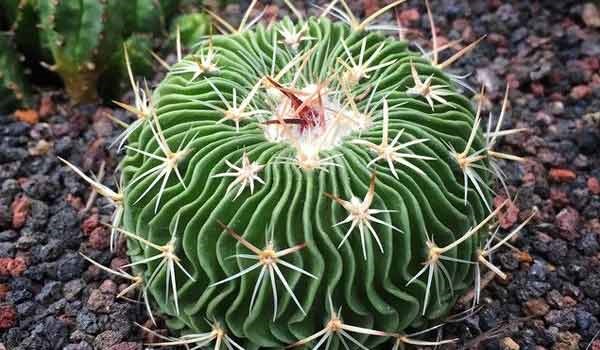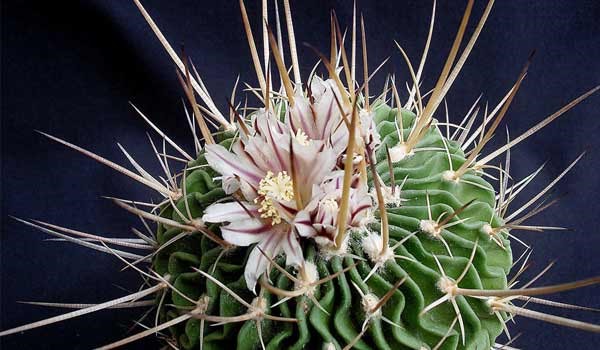Stenocactus Multicostatus (Brain Cactus) Guide

The world of succulents always has something to amaze us. Among all the exotic cacti, the brain cactus is another specimen that captures the eye. Botanically called stenocactus multicostatus, the globular and wrinkled shape of this low-growing complements any garden or decoration indoors; and as you would imagine, it is a low-maintenance cactus.
Brain cactus is also known as “wave cactus”; and in the following, we are going to tell you all you need to know about this adorable plant, from its size to care tips and common problems. By the end of this article, you will be wondering why you already do not have a brain cactus at your house!
Brain Cactus Description
The scientific name of this plant comes from the Greek words “stenos” and “multicostasus”, meaning narrow and multiple ribs respectively. When it is young, people also call it the “White Cactus”, as it is covered with white felt. Some of its known varieties are:
- Stenocactus Crispatus, with long spines that cover the ribs;
- Stenocactus Phyllcanthus, with erect spines and yellow blooms;
- Stenocactus Coptonogonus, with stiff ribs and short spines.
The brain cactus itself comes from dry parts of Mexico including Chihuahua, Zacatecas, Nueva Leon, Coahuila and Durango, and San Luis Potosí, where it can hide in rocky soils and tolerate droughts.
As mentions, this cactus is a low-growing plant that grows up to 5 inches (12.5 cm) in height and up to 6 inches (15 cm) in width. The dark green globular shape of stenocactus multicostatus stem has densely packed wavy ribs. When mature, brain cactus can have up to 100 ribs
Its spine groups are arranged somewhat crosswise on the ribs. The spines that are closer to the tops, are hard and straight. And as you move down, the spines point more downwards.
Brain cactus delicate flowers turn it into a gorgeous and even more decorative plant. They are white or pinkish violet and can grow to 1 inch (2.5 cm) in diameter.
Despite all this beauty, the wave cactus has no known medicinal properties. However, there are also no known facts about its toxicity for pets or children.

Stenocactus Multicostatus Cactus Care
The rare brain cactus that you choose, will be fairly convenient to grow. These are the important stenocactus multicostatus care tips that will always keep your plant healthy and vibrant:
Light
This specimen prefers full sun. But in the wild, it hides between rocks to evade sunlight. Therefore, you can grow it outdoors on patios, but do not forget to protect them from direct sunlight in heatwaves, as well as strong winds.
Temperature
Although it comes from drylands, this plant thrives best in moderate temperatures like -7 to 10 degrees Celsius. If growing outside, bring the potted plant inside in colder temperatures.
Water
It is best to let the soil almost dry out completely before watering your stenocactus multicostatus cactus. Depending on its size and pot, watering the brain cactus every 10 days during the warm seasons is a good idea. Reduce this amount to once every couple of weeks in colder months.
After each irrigation, empty the drip tray to avoid high humidity and root rot; which is really common when it comes to the wave cactus sensitive roots.
Humidity
High humidity can be a reason for the brain cactus dying. So do not mist this plant. The best method is to simply let the soil dry out, water thoroughly, and then leave it until the soil is dried out again.
You can also add water to the drip tray, let the stenocactus multicostatus get the necessary amount until it saturates, and empty the drip tray at the end.
Soil
Your brain cactus can survive almost any type of soil, as long as it is well-draining. We recommend using a mineral substrate for the best results.
If you want to plant this succulent in the garden, consider a 15-centimeter space for its spines and avoid mixing it in with other plants. Also. To simulate its rocky habitat as well as creating a charming view, place some pebbles at its base.
Potting
Potting and repotting the brain cactus is very important in its care, as it prevents diseases. You should transplant this succulent with extra care because it has sensitive roots that are easily damaged.
For repotting, let the soil dry out completely first. After removing the plant from the pot, shake off the soil. When the wave cactus root is fully exposed, inspect them closely and remove the rotted or dead ones. Treat the cut roots with fungicide and repot it (spread the roots).
After a week and when the wave cactus is familiar with its new pot, you can start watering the plant again.
Pro Tip: Use plastic pot for planting stenocactus multicostatus. Not because they are super affordable or light, but because they do not overheat quickly. And when they get hot, they will maintain it for a while, keeping the cactus warm and comfortable during the night.
Fertilizer
For encouraging your plant to bloom and grow best, you can feed it liquid cacti fertilizers regularly (every month) during its growing season, which is from early spring to early fall.

Propagating Brain Cactus
Because of its slow growth rate, most people tend to find brain cactus for sale and buy them. But if you are a true enthusiast, there are two options for propagating any common or rare brain cactus:
Brain Cactus Offshoots
Offshoots are not a common sight when growing a stenocactus multicostatus. Additionally, most people leave them in the same pot, so they can enjoy their spectacular cactus with multiple stems.
But if you wanted to propagate using offshoots, simply let the soil dry out. Next, remove the offshoots carefully, and plant them in another pot. Similar to repotting process, wait for at least a week before watering it again.
Stenocactus Multicostatus Seeds
For more patient people, propagating this plant from the seeds is a great choice. You can harvest the seeds that you need from stenocactus multicostatus flower fruits, or purchase them from a reputable dealer.
To propagate the dry and clean seeds, that germinate easily, all you need is a seedling starter mix. Simply press the seeds into the soil, and place the pot in a spot with proper natural light. Keep the soil slightly moist for a couple of weeks until they germinate.
If you cannot provide enough light, use led grow lights. Also, using a seed mat increases your chances of success significantly.
The wave cactus is going to shine and attract attention to your collection. You can grow it outdoors and indoors, and it is also a good choice for beginner gardeners. You can also grow its offshoots and gift them to family and friends.
Your brain cactus is waiting for you somewhere. Do not let it wait more and bring it home!
- In this post:
- Brain Cactus Description
- Stenocactus Multicostatus Cactus Care
- Propagating Brain Cactus



